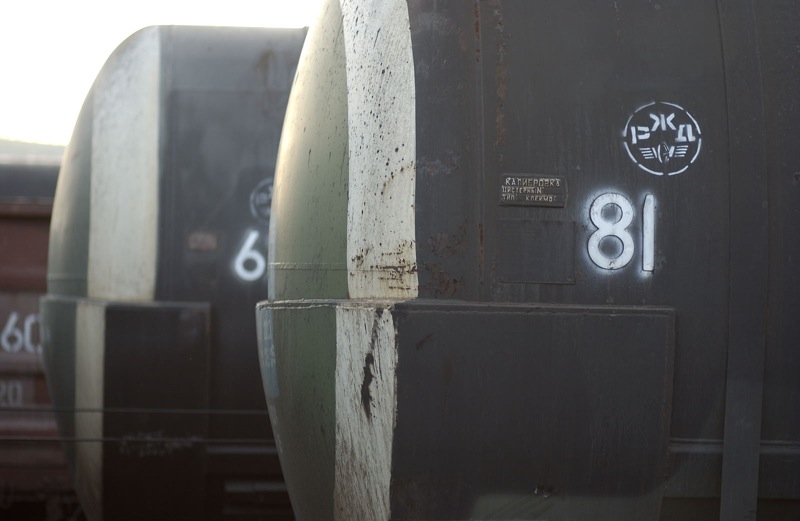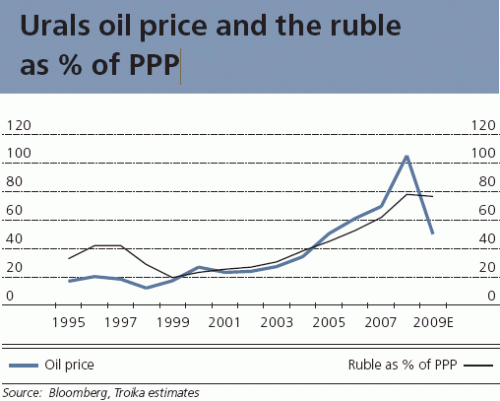
Oil prices have plummeted in recent weeks, hitting a 20-month low of $59 per barrel, a 60 percent drop-off from its summer high of $147. One might reasonably think that this would be crippling to a country like Russia, which relies so heavily on energy exports to stake its claim to major power status.
The Troika Dialog team, though, argues that it’s much more complicated than that.
In its latest Strategy Monthly [PDF], they ask, “How Does Russia Look at $50 Oil?” Their answer:
- Massive terms of trade shock. In an environment of low commodity prices (exemplified by $50/bbl oil), Russia would see its exports halve at the same time as capital flows turn negative. It would then run deficits in the order of $60 bln for the current account, $50 bln for the capital account and $30 bln for the fiscal balance.

- At $50/bbl oil, the ruble would look expensive. Rising commodity prices have increased the value of the ruble from 20% to 80% of its fair value in the period since 1998; if they fall back again, the ruble would look expensive for a middle+income country.
- The government has the firepower to defend the ruble. We calculate that even after the $280 bln of pledges made to help the economy weather the credit crunch, the government still has $395 bln of forex reserves with which it can either defend the ruble for an extended period or manage a weakening of the ruble. The key issue is timing. If commodity prices stay low for less than a year, the government can hold the ruble, at the expense of domestic growth. If, however, we are entering into a long global recession, then it is likely that the government will allow the ruble to fall. We expect the government to hold the ruble until the global picture becomes clearer.
- Where could the ruble settle? If the government does decide to allow the ruble to fall, we estimate that it would drop by around 30% to a level of R35/$1, at which point the current account and fiscal account would balance and domestic growth would be stimulated by import substitution.
- What would this mean for earnings? We calculate that, with commodity prices low and the currency weaker, RTS index earnings would fall by 37% in 2009, and that in addition, major listed companies would need to write off around $40 bln in forex losses. Fertilizers and gold are more resilient, while steel and base metals are more exposed.
- Forming the bottom of the market. As in 1998, the market would likely bottom shortly after any softening of the ruble. A weaker ruble would stimulate domestic manufacturers and would increase exporters’ profitability. We calculate that, in the event of a 30% weakening, the RTS Index would trade at a 2009 P/E of 5.4 and a P/BV of under 1.0. Moreover, the silver lining of lower commodity prices is likely to be more government reforms and a focus on returns on capital. Themes to play. Until there is greater clarity on global growth, we believe that the RTS Index will remain vulnerable. The most attractive opportunity is high dollar bond yields, where VTB, Transneft, Gazprom Neft and Norilsk Nickel stand out with yields of up to 20% or government backing. Otherwise, we like deep value+oriented themes such as: companies with large cash piles like Surgutneftegaz, the Federal Grid Company, and KazMunaiGas; exporters with low P/BV multiples, including Novolipetsk Steel, Magnitogorsk Steel, Peter Hambro Mining and TNK+BP; and domestics with low P/Es, such as Magnit, Cherkizovo Group, IBS Group and Sberbank.
One might hope that diverting massive resources to prop up the ruble would make it more difficult for Russia to throw its weight around in the near abroad and certainly curtail their ability to engage in military adventures in Georgia. Then again, as the American example shows, deficit spending can be sustained for quite some time.
James Joyner is managing editor of the Atlantic Council. Top photo by Flickr user Jerrold, used under Creative Commons license.
Image: russia-oil-81.jpg
